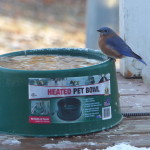People have the good fortune to sit in a warm home watching birds glean seeds outdoors in winter’s frigid weather. It is amazing that they remain active in temperatures that cause human frostbite after just minutes of exposure.
Birds have several adaptations that enable them to function in extreme cold. Perhaps most important is being clothed in highly efficient insulators – feathers. Even in our era of modern high tech insulation, goose down quilts and coats are warmer than any synthetic insulation, so the hundreds of feathers covering small birds keep them warm.
Birds have a high metabolism that produces toasty body heat but requires huge quantities of fuel. They must eat often and spend much of the day foraging. To fight the cold they devour high calorie foods such as weed seeds and frozen insects. But beef suet and sunflower seeds stocked in bird feeders also help keep them warm.
During extreme cold birds often overnight in the security of a dead tree. Tiny birds snugly pass howling blizzards tucked into small crevices. Wood is a relatively efficient insulator and birds squeeze between the bark and wood or in holes excavated by woodpeckers. Bird houses erected in spring to attract nesting wrens or bluebirds serve double duty as safe roosting sites.
Unfortunately winter is the season of death for many birds and other small wild animals. Cold, wind, snow, lack of food and predators take their toll and only a fortunate small percentage of young wild animals live until their first birthday.

This winter we have seen as many as four male and one female bluebirds at one time at our “dogfeeder” waterer.
During the winter provide plenty of seed and suet for the birds. And, remember that critical element – water!
Homeowners can help birds safely winter by protecting dead trees and erecting bird houses before cold weather arrives. Put the latter on your list to do this spring and give the birds a hand for next winter.

